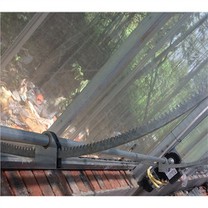Four uses of diffuse scattering glass for glass greenhouses
Today, with the rise of glass greenhouses, more and more solar greenhouses and film greenhouses are ushered in and updated. The main consumables of solar greenhouses and film greenhouses are covering materials. Covering materials are replaced once a year and a half on average in solar greenhouses, and once a year on average in film greenhouses.
As a basic facility in agriculture today, glass greenhouses use glass with an average service life of 15 years. There are two main specifications of the slow-scattering glass used on the greenhouse, one kind of diffuse scattering glass with 91.5% standard light transmittance, and one kind of diffuse glass with high light transmittance after coating of 97.5% (anti-reflection glass). There are 8 types in total. The haze specification is suitable for different heights of the greenhouse and the special requirements of the light on the glass. First, let’s briefly understand the conventional thickness of the greenhouse scattering glass. The recommended thickness is 4mm, and the other is 5mm. The difference between 4mm and 5mm lies in heat preservation and safety. For everyday use in a greenhouse there is no problem.
Furthermore, there are four major uses of greenhouse diffuse scattering glass for greenhouse planting:
1: Turn hard light into soft light Diffuse glass for crop growth (especially for vertical planting), thanks to the smaller shadow on the back of the shelter, soft light can penetrate deeper into the vertical depth of the crop. When we adjust the size of the light source and the distance between the crops to the best conditions, the crops and leaves will reach a state of no shadows. In other words, there is no height limit for vertical cultivation of crops in diffuse glass-covered greenhouses.
2: Reduce the temperature of the leaf surface Compared with ordinary float glass, the scattering glass can increase the yield of vegetables by 7-12% in terms of crop growth. Shorten the growth cycle of ornamental crops.
The scattered light evens out peaks in leaf temperature, creating more sustainable growing conditions. For fruit, the effect on nutrient absorption is greater than the effect on growth rate. In many plantings and experiments, it was found that the leaf temperature of the top layer of crops was higher under float glass than under diffuse glass (equal distance test). Especially it reaches its peak at 12:00 to 14:00, when the temperature exceeds 32 degrees Celsius. 32 degrees Celsius is the upper limit of the comfortable growth temperature for most fruits and vegetables, which will cause the crops to slow down or stop growing for two hours at noon every day. The leaf surface temperature of the crops under the diffuse glass fluctuates in the range of -2 to +2 degrees Celsius, which is more stable than the -2 to +6 degrees Celsius of the float glass. This means that under the conditions of float glass, the environmental control system and irrigation system face more severe challenges. Generally speaking, the air temperature in the greenhouse is set to be 2-3 degrees Celsius higher than the leaf temperature (30 degrees Celsius for most plants), which can ensure relatively good and stable growth of the plants.
3: Increased production efficiency The haze of the scattering glass refers to the index value of the scattered light. The higher the haze, the larger the spot treated by the material. The optimal size of the spot is determined by the design size and height of the greenhouse. To make things more complicated, since hemispheric irradiation affects crop yield, for every 1% increase in hemispheric irradiation, 0.8% of tomato yields increase. The selection of the haze value will be considered in a certain order so that the crops can obtain the maximum hemispherical irradiance value, which means that the minimum haze value can be selected.








